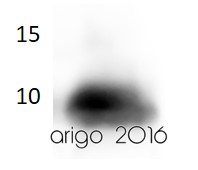ARG62461
anti-Cytochrome C antibody [6H2.B4]
anti-Cytochrome C antibody [6H2.B4] for Flow cytometry,ICC/IF,Immunoprecipitation,Western blot and Human,Mouse,Rat
Cancer antibody; Cell Biology and Cellular Response antibody; Cell Death antibody; Metabolism antibody; Signaling Transduction antibody

2
Overview
| Product Description | Mouse Monoclonal antibody [6H2.B4] recognizes Cytochrome C |
|---|---|
| Tested Reactivity | Hu, Ms, Rat |
| Tested Application | FACS, ICC/IF, IP, WB |
| Host | Mouse |
| Clonality | Monoclonal |
| Clone | 6H2.B4 |
| Isotype | IgG1, kappa |
| Target Name | Cytochrome C |
| Antigen Species | Rat |
| Immunogen | Rat cyt c-OVA |
| Conjugation | Un-conjugated |
| Alternate Names | CYC; HCS; Cytochrome c; THC4 |
Application Instructions
| Application Suggestion |
|
||||||||||
|---|---|---|---|---|---|---|---|---|---|---|---|
| Application Note | * The dilutions indicate recommended starting dilutions and the optimal dilutions or concentrations should be determined by the scientist. |
Properties
| Form | Liquid |
|---|---|
| Purification | affinity chromatography |
| Buffer | PBS (pH 7.2) and 0.09% Sodium azide |
| Preservative | 0.09% Sodium azide |
| Concentration | 0.2 mg/ml |
| Storage Instruction | For continuous use, store undiluted antibody at 2-8°C for up to a week. For long-term storage, aliquot and store at -20°C or below. Storage in frost free freezers is not recommended. Avoid repeated freeze/thaw cycles. Suggest spin the vial prior to opening. The antibody solution should be gently mixed before use. |
| Note | For laboratory research only, not for drug, diagnostic or other use. |
Bioinformation
| Database Links | |
|---|---|
| Gene Symbol | Cycs |
| Gene Full Name | cytochrome c, somatic |
| Background | This gene encodes a small heme protein that functions as a central component of the electron transport chain in mitochondria. The encoded protein associates with the inner membrane of the mitochondrion where it accepts electrons from cytochrome b and transfers them to the cytochrome oxidase complex. This protein is also involved in initiation of apoptosis. Mutations in this gene are associated with autosomal dominant nonsyndromic thrombocytopenia. Numerous processed pseudogenes of this gene are found throughout the human genome.[provided by RefSeq, Jul 2010] |
| Function | Electron carrier protein. The oxidized form of the cytochrome c heme group can accept an electron from the heme group of the cytochrome c1 subunit of cytochrome reductase. Cytochrome c then transfers this electron to the cytochrome oxidase complex, the final protein carrier in the mitochondrial electron-transport chain. Plays a role in apoptosis. Suppression of the anti-apoptotic members or activation of the pro-apoptotic members of the Bcl-2 family leads to altered mitochondrial membrane permeability resulting in release of cytochrome c into the cytosol. Binding of cytochrome c to Apaf-1 triggers the activation of caspase-9, which then accelerates apoptosis by activating other caspases (By similarity). [UniProt] |
| Cellular Localization | Mitochondrial intermembrane space |
| Highlight | Related Antibody Duos and Panels: ARG30271 Mitochondrial Marker Antibody Panel (Cytochrome C, COX4, HSP60) ARG30276 Cytochrome-C fractionation Antibody Panel (Cytochrome-C, COX IV, beta Actin) Related products: Cytochrome C antibodies; Cytochrome C Duos / Panels; Anti-Mouse IgG secondary antibodies; Related news: Understanding Your Cells: Choose the right markers |
| Research Area | Cancer antibody; Cell Biology and Cellular Response antibody; Cell Death antibody; Metabolism antibody; Signaling Transduction antibody |
| Calculated MW | 12 kDa |
| PTM | Binds 1 heme group per subunit. Phosphorylation at Tyr-49 and Tyr-98 both reduce by half the turnover in the reaction with cytochrome c oxidase, down-regulating mitochondrial respiration. |
Images (1) Click the Picture to Zoom In
Customer's Feedback









